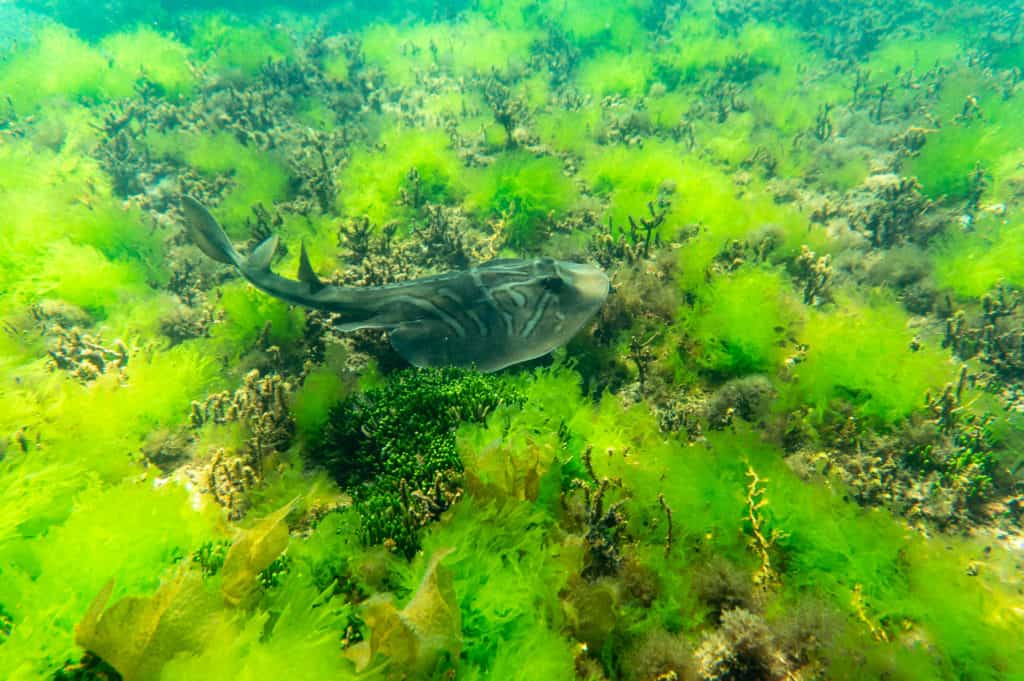VCE Biology Fieldwork (Unit 2 Area of Study 2 and 3)
-
Biodiversity
-
Homeostasis and osmoregulation
-
Intertidal communities and food webs
-
Adaptations
-
Relationships between abiotic and biotic factors
-
Species identification
-
Species abundance and distribution
-
Field observation and data interpretation
-
Natural resource management



VCE Biology students will learn biological concepts and undertake field research techniques to enable them to fulfil the assessment requirements for school-assessed coursework (SACs) in scientific investigation.
The physiology and behaviour of common intertidal species within Ricketts Point Marine Sanctuary will be explored. Applying an ecological perspective, students will undertake an area study to observe and determine how species adaptations, relationships and interactions with abiotic factors in the environment influence their survival in this challenging habitat. Insight provided into the function of physiological systems (e.g. homeostasis and osmoregulation) within an aquatic environment will reinforce students’ classroom learning.
Students will have an opportunity to develop their fieldwork skills including the use of quadrat surveys, species identification and classification techniques (e.g. the dichotomous key), field observation and data recording, as they investigate the distribution and abundance of intertidal reef species. Through discussion, students will be enabled to formulate hypotheses and interpret data results to develop conclusions for compilation into scientific reporting.
This program delivers:
– Overview of Victoria’s Marine National Parks systems and the role they play in the protection of Victoria’s marine biodiversity.
– Developing knowledge of the role of research and data collection in the management of Victoria’s marine resources.
– Discussion and presentations introducing key intertidal species, intertidal communities, concepts regarding food webs and species interactions and the influence of abiotic factors in the coastal/marine environment.
– An (ecological) area study introducing students to field observation, data recording techniques, species identification, classification and environmentally responsible behaviour.
– Practical experience in gathering species distribution and abundance data using quadrat surveys, data collection and data interpretation.
Inclusions and Notes
Restrictions: Delivery of program is tide dependent. Please provide alternative dates that spread across at least two weeks.
Prior knowledge required: A short preparatory exercise will be provided to classroom teachers to be undertaken by students in advance of their field trip to Ricketts Point. The material is pertinent to enabling students to adequately engage with field studies on the day. The preparatory material will provide students with a background understanding of key abiotic factors and their impacts in marine and coastal environments and species adaptations.
Some degree of understanding of food webs and trophic levels and homeostasis and osmoregulation will be advantageous for students. Familiarity in the use of dichotomous keys, species identification charts and scientific nomenclature will be helpful as would be knowledge of data collection techniques including quadrat surveys.
The sampling techniques used in this program are based Parks Victoria Sea Search moderate-level of difficulty sampling method for intertidal reefs. It is recommended teachers and students review intertidal species identification charts for Ricketts Point Marine Sanctuary and quadrat sampling methods (found at https://www.parks.vic.gov.au/get-into-nature/volunteering/sea-search).
Equipment needed: A copy of workbook, clipboard and pencil per student. Appropriate clothing and footwear (long sleeve top, long pants, jacket, hat/beanie, soft-soled shoes e.g. runners). Students will need a snack/lunch and water.
Equipment supplied by Gould: Tape measure, quadrats, algal dichotomous keys, species identification charts.
Curriculum Links
VCE Biology Unit 2 (Area of Study 2/Outcome 2)
Adaptations and Diversity
- the biological importance of genetic diversity within a species or population
- structural, physiological and behavioural adaptations that enhance an organism’s survival and enable life to exist in a wide range of environments
- survival through interdependencies between species, including impact of changes to keystone species and predators and their ecological roles in structuring and maintaining the distribution, density and size of a population in an ecosystem
VCE Biology Unit 2 (Area of Study 3/Outcome 3)
Scientific Evidence
- the distinction between primary and secondary data
- the nature of evidence and information: distinction between opinion, anecdote and evidence, and scientific and non-scientific ideas
- the quality of evidence, including validity and authority of data and sources of possible errors or bias
Scientific Communication
- biological concepts specific to the investigation: definitions of key terms; use of appropriate biological terminology, conventions and representations
- characteristics of effective science communication: accuracy of biological information; clarity of explanation of biological concepts, ideas and models; contextual clarity with reference to importance and implications of findings; conciseness and coherence; and appropriateness for purpose and audience
- the use of data representations, models and theories in organising and explaining observed phenomena and biological concepts, and their limitations
- the influence of social, economic, legal and political factors relevant to the selected research question
VCE Study Design extracts reproduced by permission, © VCAA. VCE is a registered trademark of the VCAA. The VCAA does not endorse or make any warranties regarding this study resource. Current VCE Study Designs, past exams and related content can be accessed directly at www.vcaa.vic.edu.au
